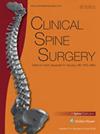Transforaminal Versus Lateral Interbody Fusions for Treatment of Adjacent Segment Disease in the Lumbar Spine
IF 1.7
4区 医学
Q3 CLINICAL NEUROLOGY
引用次数: 0
Abstract
Study Design: Retrospective comparative study. Objective: This study compared outcomes for patients managed with a lateral approach to interbody fusion [lateral (LLIF) or oblique (OLIF)] versus a posterior (PLIF) or transforaminal interbody fusion (TLIF) for treatment of adjacent segment disease (ASD) above or below a prior lumbar fusion construct. Summary of Background Data: No study has compared outcomes of lateral approaches to more traditional posterior approaches for the treatment of ASD. Methods: Retrospective review was performed of patients who underwent single-level lateral or posterior approaches for lumbar interbody fusion for symptomatic ASD between January 2010 and December 2021. Exclusion criteria included skeletal immaturity (age below 18 y old) and surgery indication for malignancy or infection. Patient demographics, medical comorbidities, operative details, postoperative complications, and revision surgery profiles were collected for all patients. Standard descriptive statistics were used to summarize data. Comparative statistical analyses were performed using Statistical Package for the Social Sciences (Version 28.0.1.0; Chicago, IL). Results: A total of 152 patients (65±10 y) were included in the study with a mean duration of follow-up of 1.6±1.4 years. The cohort included 123 PLIF/TLIF (81%), 18 LLIF (12%), 11 OLIF (7%). TLIF/PLIF experienced greater mean operative time (210±62 min vs. 184±80 OLIF/105±64 LLIF,治疗腰椎相邻节段疾病的经椎间融合术与外侧椎间融合术
研究设计:回顾性比较研究。研究目的本研究比较了采用侧位椎体间融合术(侧位(LLIF)或斜位(OLIF))与后位(PLIF)或经椎孔椎体间融合术(TLIF)治疗既往腰椎融合术结构上方或下方邻近节段疾病(ASD)患者的疗效。背景数据摘要:还没有研究比较过侧方入路与更传统的后方入路治疗 ASD 的效果。方法:对 2010 年 1 月至 2021 年 12 月间因症状性 ASD 而接受单侧或后路腰椎椎间融合术的患者进行回顾性研究。排除标准包括骨骼不成熟(年龄低于18岁)、手术指征为恶性肿瘤或感染。研究人员收集了所有患者的人口统计学资料、合并症、手术细节、术后并发症和翻修手术资料。数据汇总采用标准描述性统计方法。使用社会科学统计软件包(28.0.1.0 版;伊利诺伊州芝加哥市)进行比较统计分析。结果研究共纳入 152 名患者(65±10 岁),平均随访时间为 1.6±1.4 年。其中包括123例PLIF/TLIF(81%)、18例LLIF(12%)和11例OLIF(7%)。TLIF/PLIF的平均手术时间(210±62 min vs. 184±80 OLIF/105±64 LLIF,P<0.001)和估计失血量(414±254 mL vs. 49±29 OLIF/36±33 LLIF,P<0.001)更长。术后并发症发生率无明显差异。与PLIF/TLIF(16,13%)相比,OLIF(7,64%)和LLIF(7,39%)术后根性疼痛明显更严重,P<0.001。两组患者在使用医疗服务方面没有明显的统计学差异。结论:侧位融合术治疗 ASD 的并发症风险与后位方法相比无明显差异。我们的研究表明,后路方法的手术时间和估计失血量明显增加,侧路方法操作/牵拉腰肌导致根性疼痛的风险增加。证据等级:三级。
本文章由计算机程序翻译,如有差异,请以英文原文为准。
求助全文
约1分钟内获得全文
求助全文
来源期刊

Clinical Spine Surgery
Medicine-Surgery
CiteScore
3.00
自引率
5.30%
发文量
236
期刊介绍:
Clinical Spine Surgery is the ideal journal for the busy practicing spine surgeon or trainee, as it is the only journal necessary to keep up to date with new clinical research and surgical techniques. Readers get to watch leaders in the field debate controversial topics in a new controversies section, and gain access to evidence-based reviews of important pathologies in the systematic reviews section. The journal features a surgical technique complete with a video, and a tips and tricks section that allows surgeons to review the important steps prior to a complex procedure.
Clinical Spine Surgery provides readers with primary research studies, specifically level 1, 2 and 3 studies, ensuring that articles that may actually change a surgeon’s practice will be read and published. Each issue includes a brief article that will help a surgeon better understand the business of healthcare, as well as an article that will help a surgeon understand how to interpret increasingly complex research methodology. Clinical Spine Surgery is your single source for up-to-date, evidence-based recommendations for spine care.
 求助内容:
求助内容: 应助结果提醒方式:
应助结果提醒方式:


